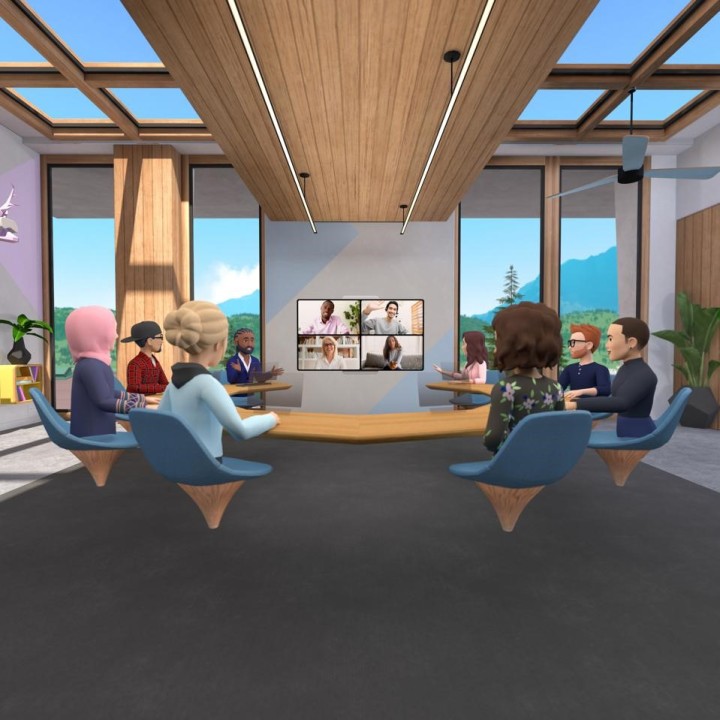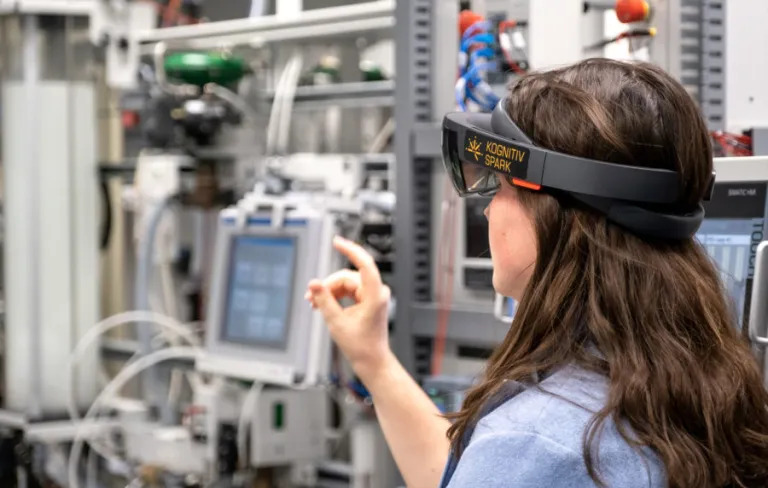As remote work become more common in today’s work environment, social virtual reality (social VR) introduces a new way for teams to gather online. In the right situations, it serves as a more engaging alternative to traditional digital platforms.
Shifting mediums can address some of the key challenges remote teams face in a distributed workplace, such as feeling disconnected and finding it hard to build relationships with their team or company.
Social VR can create a more engaging and immersive experience, making team members feel more connected and present, as if they were in the same room. This level of presence can lead to improved collaboration, creativity, and overall team dynamics, which are foundational elements in creating a remote workspace.
Common questions: Why choose VR? What advantages does it provide? How to get started?
When it comes to remote teams and picking immersive tools, people often wonder about its practicality and how easy it is to use. Some may question whether it’s accessible to everyone on the team or if it truly helps build connections.
This article will address common questions and misconceptions about social VR for remote teams. We’ll discuss its advantages and limitations. And share real-world case studies to inspire your exploration of this innovative technology.
Digital Meetings: Efficiency vs. Engagement
Imagine signing into a digital conference call, where each participant is a small window on your screen. Their voices merge into a singular stream of conversation. It’s efficient and scalable—capable of connecting hundreds or even thousands of people.
In these digital meetings, the conversational essence often gives way to structured agendas, where specific speakers guide the discussion. Interactive features like the raise hand function, the chat, or emoji reactions offer a semblance of engagement, yet many participants remain muted, their cameras switched off, reducing their presence to mere icons on a screen. While expansive, such formats tend to dilute the personal touch that smaller, more engaging gatherings hold.
Digital platforms are effective for widely broadcasting information, such as company announcements, new directions, and features. It’s more interactive than just reading a webpage, yet its main purpose is to distribute information rather than encourage dialogue, idea sharing, or debate.
Pros:
- Efficient and scalable connectivity
- Wide-reaching communication capabilities
- Effective for broadcasting information
Cons:
- Structured agendas limit conversation flow
- Muted mics and off cameras reduce engagement
- Prioritizes information distribution over dialogue
Spatial Meetings: Interactive vs. Streamlined
Now, compare that to the experience of activating a social VR app. Suddenly, you find yourself in a virtual campus or meeting area, where participants are represented by avatars, not just static images. This experience goes beyond merely seeing avatars; it immerses you in a setting that feels real.
This medium is best for groups of 5 to 50 people, providing an environment that encourages dynamic interaction and hands-on engagement. Participants can freely move and interact with others, contributing ideas and actively participating in various activities.
Spatial audio allows you to engage in conversations with the entire group or have a private chat with someone nearby, mimicking real-life interactions. VR isn’t limited to voice communication; you can also use hand gestures, nod your head, and express emotions, enriching the way we connect. In this virtual environment, everyone is part of the same space, fully present and engaged.
Pros:
- Immersive and realistic virtual environments
- Spatial audio enhances group communication
- Adding body language and facial expressions
Cons:
- May have a learning curve for some users
- Dependent on stable internet connection
- Potential for VR motion sickness or discomfort
Unlocking VR’s Potential: Finding the Right Contexts
Virtual reality (VR) presents numerous opportunities to enhance collaboration and engagement in remote environments. Let’s explore specific contexts where VR truly shines, offering immersive experiences designed to meet diverse team needs and objectives.
Small Groups: Perfect for intimate discussions where every voice matters. In these settings, team members can actively engage and connect on a deeper level.
Brainstorming: Ideal for sparking creativity with real-time idea sharing. Teams can visualize concepts, share insights, and explore innovative solutions together.
Department Meetings: Convenient and inclusive gatherings for larger networking opportunities, enabling multiple teams to convene virtually and foster synergy and cross-collaboration.
Thought Leadership: Inspiring talks and discussions with industry experts. Participants gain valuable insights and perspectives, fostering professional growth and development.
Training Simulations: Hands-on learning in a safe, immersive environment. Teams can actively participate in virtual simulations to practice skills, scenarios, and procedures.
Social Activities: Virtual experiences for team building. From interactive meditation sessions to immersive virtual tours, teams can engage in activities promoting camaraderie and team cohesion.
VR is not a one-size-fits-all solution
While VR brings exciting opportunities to the digital world, it’s not always the best fit. Here are some examples where social VR might not meet your needs, underscoring the technology’s limitations in certain scenarios.
Mass Communication: For large-scale events like company-wide meetings, live streaming or webinars will be more practical. The scale of these events restricts VR’s effectiveness due to technical constraints and the challenge of engaging a large, distributed audience.
Most virtual spaces can only accommodate 50-70 participants per instance, and not every platform has an ‚On-Air‘ function necessary for broadcasting a live speaker to multiple simultaneous sessions.
Policy or compliance updates are often better communicated through simpler digital formats like emails or intranet postings. VR’s immersive and interactive aspects might not enhance the reception of this type of content, making it an unnecessary complication.
Time-sensitive Announcements: When information needs to be relayed quickly and efficiently to a broad audience, the immediacy and simplicity of traditional communication tools like instant messaging or updates to documentation are preferable. Setting up VR experiences for urgent communications would delay the message.
Device Compatibility Check: It’s important to make sure that VR technology works with everyone’s devices. Teams should choose a platform that suits most members and be ready to accommodate any additional needs. Given the range of social VR apps and their device compatibility, this should be part of the platform selection and integration strategy.
Cross-Platform Functionality in Social VR
Some people think that to join virtual meetings or collaborative activities, you must have a VR headset. But that’s not entirely true. Many platforms offer alternatives like browser-based experiences or mobile accessibility. This means you can engage in spatial networking without needing special equipment.
When choosing a social VR platform, prioritize those that support cross-platform functionality. This ensures that team members with different devices, whether PC, Mac, or mobile, can all participate.
Some popular examples: EngageXR, Glue, Rec Room, and FrameVR.
Real-World Case Studies
Let’s look into some real-world case studies of organizations leveraging social VR for their remote team experience. These examples highlight the practical applications and benefits of integrating XR (extended reality) technologies into global work environments.
- Interview with Michael Wynn from Bank of America (Engage)
- Enable employees to meet, learn & collaborate in new ways (Accenture)
- Saved $3 million in 3 months with VR BIM reviews (Fortis Construction)
- Exploring the future of teaching (Institute of Transport Planning and Traffic Engineering)
- From pixels to high-fives: Real connections for virtual offices (LGU+)
- Recruiting in the Metaverse (Capgemini)
- Internal learning event to build a shared XR understanding (UCLPartners)
- LinkedIn LEADVR: Navigating the Metaverse (LinkedIn)
- Hometime Employee Hangout (Hometime)
- Cuts 75% training time with VR (Boeing)
- Metaverse product launch events (Lufthansa, RAUM)
- A new take on vehicle devleopment (BMW)
- What does the Future of Work look like? (LinkedIn)
- Looks weird, but welcome to the Global Office of the Future (Fable Food Co.)
- Opportunities and challenges for financial service providers and insurance companies (ERGO Group AG, Airport LBE)
- Electric Safe, engaging and effective training with VR (Accenture)
- A new approach to soft skill development (Deloitte)
- How VR is Transforming the Way We Train Associates (Walmart)
- UPS Invests Millions in Advanced Training for On-the-Road Drivers (UPS)
- Audi uses modular solution for virtual-reality training (Audi)
- AR and VR in the workplace (IBM)
- Virtual reality with real benefits (Airbus)
- Relevance to the Future of Logistics (DHL)
Conclusion
Social VR offers immersive, interactive experiences. These should complement traditional digital workspace strategies. Using VR in the right situations can enhance team interactions, making them more engaging and productive.
The choice between VR and conventional methods should depend on the specific needs of the gathering, with VR being a compelling option for situations requiring high interaction and presence.
Its unique blend of social presence, interactivity, and spatial dynamics makes social VR a powerful tool for communication and collaboration. By recognizing its strengths and limitations, we can leverage VR to create in-person experiences as meaningful and productive as physical interactions.
Quelle:



